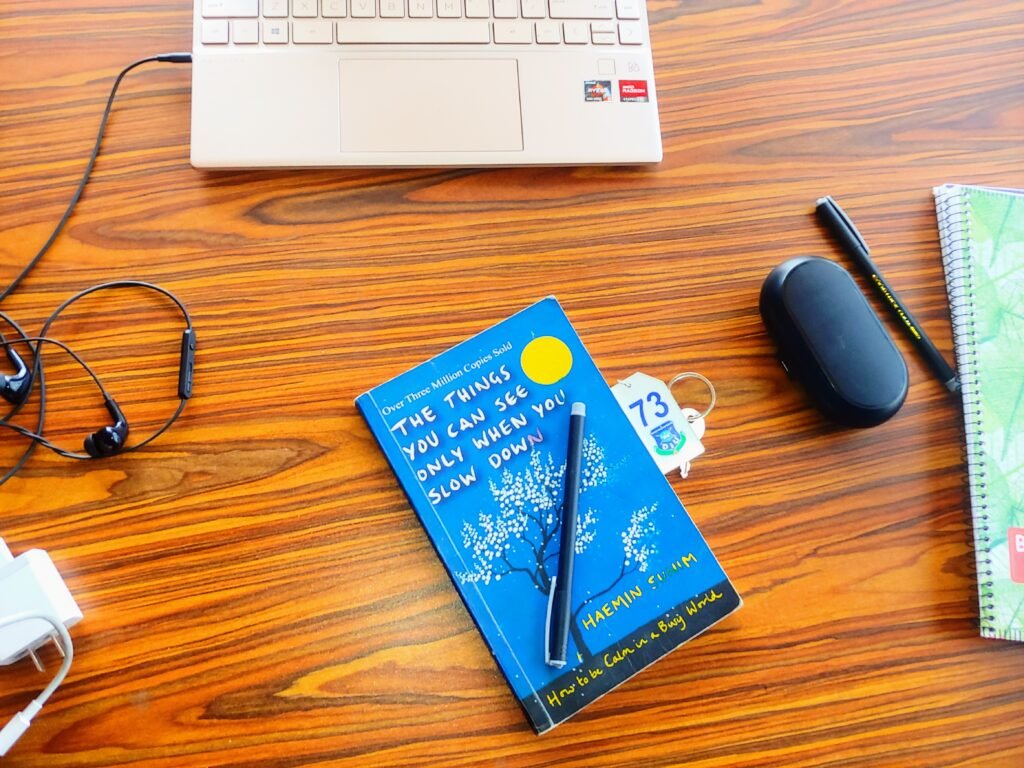Note: This article is based on the first chapter only. Therefore, one should not judge the entire book by reading this article alone.
Today I’m going to share an amazing book with you, “The Things You Can See When You Only Slow Down.”
Who is the book for?
If you are someone who is busy and finds darkness in your eyes, hindering your ability to work as you’d like, no matter how hard you try, unable to make progress in life; if you are working day in and day out just to survive in a job that you may not be interested in, then this book is for you. It is an advice book, but it differs from others. This book offers advice on what to do as well as how to do it.
The book was released in South Korea in 2012 and surprisingly stayed on the bestseller list for 41 consecutive weeks, selling over 3 million copies during that time.
Some word for writter
Before diving into this book, I would like to introduce the author. This book is written by Haemin Sunim, a South Korean Zen Buddhist teacher and author. In Korea, he is referred to as the “Healing Mentor.” As a professor in a small arts college, people often approached him with life’s challenges. He would answer these questions either directly or through various platforms such as Facebook, Twitter, and more. Whenever interesting thoughts came to his mind, he noted them down. In this way, he received an unimaginable response from people. Many were inspired by his words and found success or a new direction in life. Some found jobs, some found inspiration for a fresh start, and various publications approached him, asking him to publish his thoughts in the form of a book. Thus, he originally published this book, “The Things You Can See When You Only Slow Down.”
Now, let’s delve into this book a little.
Rest: Why am I so busy?
In our fast-paced world, we often find ourselves racing against time, chasing success, and constantly seeking the next big thing. Sometimes, in our relentless pursuit, we forget to appreciate and see the beauty around us.
But if we stop for a moment and truly observe the world, time, or even ourselves, we may question: is the world inherently busy, or have we made ourselves busy within our minds? The chapter of the book begins with this question: why am I so busy?
Later, the author realizes that we are busy because we choose to keep ourselves busy or prefer to stay busy. The world itself is neither happy nor sad; it is as we perceive it to be.
The author provides an example of a friend overseeing the construction of a meditation hall. When it came time to tile the roof, the friend saw tiles everywhere he went and meticulously attended to every detail, from the material selection to the design. Similarly, when it was time to craft a table, only the floor material was visible, and the friend scrutinized every aspect, from color to durability. From this, the author reflects that when we observe the external world, we only see the small part that interests us. The world we perceive is not the entirety of reality; it is limited. Yet, to our minds, this limited world seems vast, shaping our reality.
Think positively and spread healthy thoughts to others.
If you focus on positive or beautiful things, you will become beautiful, and the world around you will appear beautiful. Positivity will permeate your thoughts, creating a sense of harmony. Conversely, when our minds are clouded with negativity, the world appears chaotic. Therefore, it is essential to cultivate positive thoughts within ourselves and share them with others.
If you feeling sad or unhappy try this
When experiencing negative emotions, avoid isolating yourself. Instead, spend time with friends, engage in activities you enjoy with your family, watch your favorite movie at the cinema, or spend time in the garden gardening. Allow yourself to immerse in activities that bring joy. Just as food sticks to a frying pan and requires soaking to remove, negative feelings, depression, and difficult moments in life require time and attention to overcome. Allow yourself to experience these emotions fully, knowing that they will eventually pass, leaving behind the vast expanse of the mind.
Appreciate the beauty around you
If you are still suffering, take a moment to observe the nature around you. Notice the beauty in everyday moments, such as a father buying eye cream for his children or a family enjoying themselves in the park. Allow yourself to be captivated by the simple joys of life, and you will find happiness abundant.
I’ve discussed the first chapter of this book extensively.
Attention
Ninety-nine percent of your problems are self-created because you take life too seriously. Seriousness is the root cause of problems. Be playful, and you will not miss anything because life is divine.
You may imagine that your life is in ruins, but life itself is not a waste. To be born into the mortal world with a decaying body is not a waste. Just as today’s mango rots tomorrow, life’s impermanence is inherent. Therefore, your life is not wasted; rather, it is transient, as is the case for everyone.

